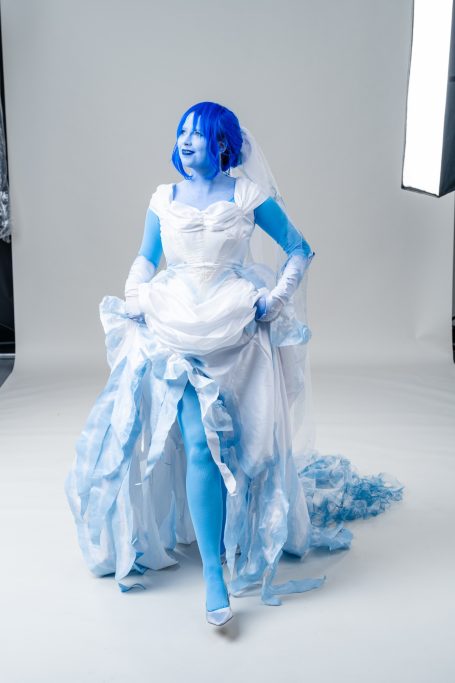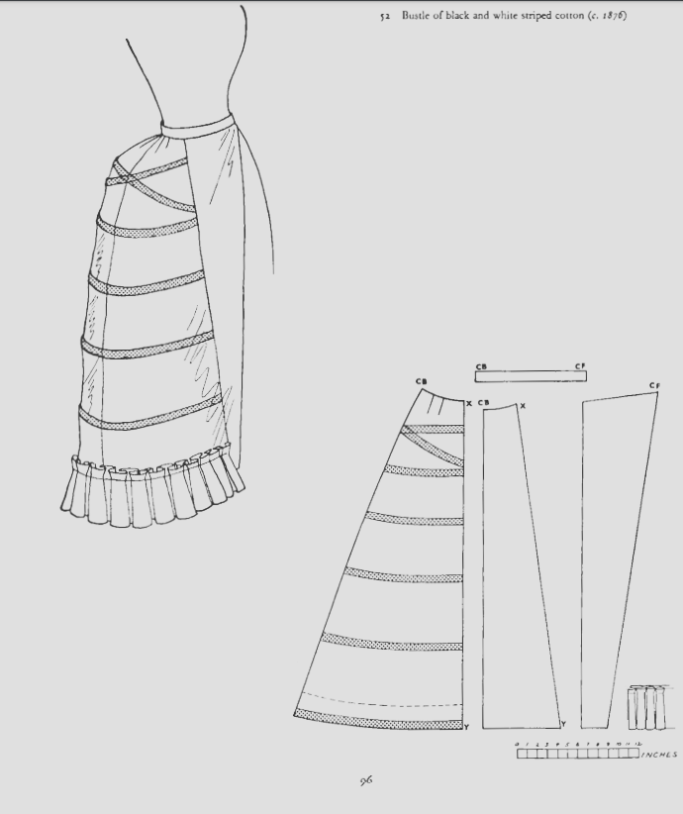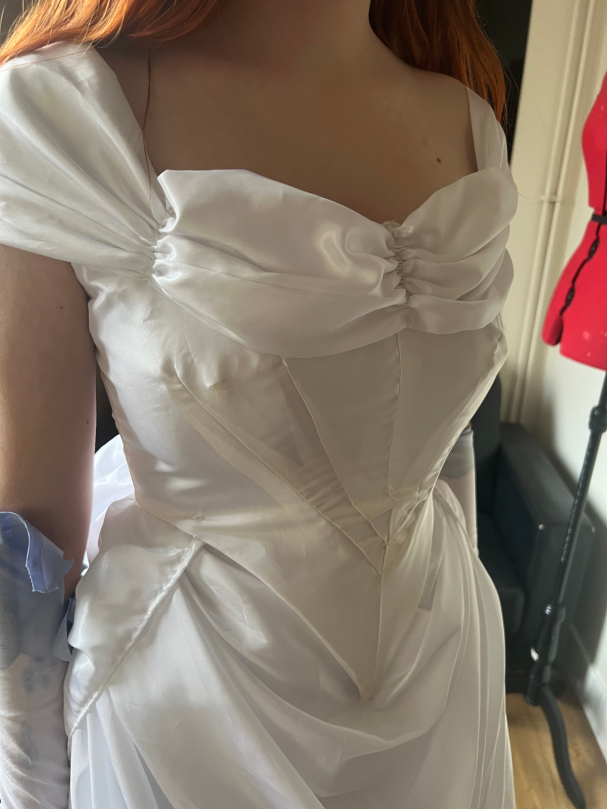Corpse Bride - NTU Element One
(Industry Project - Year 3)
This project, running from September 2023 through to January 2024, involved designing and creating a piece of work to be entered into the Patterns for Performance competition run annually by The Costume Society. For my entry, I redesigned Tim Burton's A Corpse Bride (2007) to be a theatre show, and chose a historical setting for the piece in 1890s England.
Full Project Portfolio Links:
For a full understanding of the Research portion of this project, click here to see full supporting work
For a full understanding of the Design portion of this project, click here for full design work
For a full understanding of the construction portion of this project, click here to see full construction work
Beginning the Project - The Competition
The first port of call for this project was to understand the ins and outs of how the competition would run. Using the competition's outlines as a brief would enable me to work efficiently and stay within the parameters set. The competition sated that a costume for a theatre production must be made, using patterns from Janet Arnold's Patterns of Fashion books, Norah Waugh's The Cut of Men's Clothes or The Cut of Women's Clothes. Knowing this, I could begin to research the patterns outlined to help with my design.
The Research
Once the competition was understood, I could move into breaking down the script and beginning my research. The script I used was one I was able to find online, and was a first edition of The Corpse Bride from 2005. This meant that my script and story differed from the animated film, but using a script allowed me to understand the characters and get a feel for the worlds in which the characters live.
After breaking down the script, I moved into my research. I knew I wanted to do a historical piece, and decided on the 1870s initially. What became apparent through the script and the research was that characters from all different decades would be needed to better communicate the alive and the dead characters. From the beginning of the project, I was beginning to formulate a costume in my head for Emily (The Corpse Bride) of an 1870s wedding dress. For me to be able to design this, the perfomance would have to be set later in the 19th Century. I chose the 1890s due to it's conflicting silhouettes with previous decades. This allowed me to design to design the Van Dorts in 1890s silhouettes to convey the ides of the families' newfound wealth, whereas the Everglots could wear clothes from the 1880s to establish them as a family of generational wealth.
My full researching work can be seen by clicking the link under "Full Project Portfolio Links" above
Research - Moodboards
After finishing all research, I collated what I had into moodboards for each character I was designing for. With my moodboards, I focused on pulling in the characters from the film and pairing them with era relevant fashion plates and drawings. This really helped me to visualise where I was going to take each character's costume when I entered into the design phase of the project.
(Click to enlarge images)
The Design Phase
After researching and creating moodboards, I felt comfortable to be able to move into my design. Below are the final designs for the 10 characters I chose to design for, but if you are interested in seeing the complete design phase feel free to click on the link at the top of the page.
Reasoning for my design choices are as follows:
Emily (Corpse Bride): Designed in an 1870s Wedding dress with long tattered veil. I chose this because I wanted her to have a striking silhouette. The long veil and Deep "V" on the bodice mimic choices in her original character design. This is the character I chose to carry through to construction.
Victor Van Dort: Designed in a formal dinner suit from the 1890s. This was chosen to establish him as a child of a nouveau riche family. His colour scheme mirrors that of his family to help identify them as a unit, with his waistcoat being made out of the same fabric as his mother's dress to show her influence. His blue colour scheme also links him to Emily.
Victor Van Dort - Wedding Suit: This is the same suit as Victor's previous design, but is covered with spiderweb embroidery in shiny silk thread. This is done because the spiders of the underworld fix his suit after it becomes tattered from him running through the woods.
Nell Van Dort: Designed in a dress from 1895, the dress has a flowing and dramatic overskirt trimmed with ruffles and a flowing blue underdress. The costume is designed to make her seem larger than life with fashionable large sleeves. Her accessories are in silver to contrast the Everglots' gold, and show that her money is new and different from the gold of generational wealth and titles.
William Van Dort: Designed in a suit from early 1890, with influences from the 1880s such as his top hat. This shows that his rise to wealth is new, and he is still frugal choosing to alter existing clothes. Also alludes to his wife being a social climber and money-spender as her costume is full 1890s and the alteration done to William's suit is done in Nell's dress fabric.
Victoria Everglot: Dressed in a pared-down evening dress from 1880, the dress is meant to mimic that which the animated character wears in the 2007 film. Using an evening dress shows the families' wealth, but also their frugal recycling as their finances dwindle.
Victoria Everglot - Wedding Dress: The wedding dress is designed in keeping with wedding dresses from 1895 onwards. It shows Victoria's escape from her cruel family and her break from landed gentry into nouveau riche as she marries Victor. She leaves her old-fashioned life behind to live in the present with Victor.
Maudeline Everglot: Inspiration taken from dresses of the 1870s and 80s, as well as men's suits, Madeline's dress was designed to communicate her harsh personality and her dominance over the family. Her large silhouette and blazer-style bodice speaks to her ideals of modesty and purity for Victoria but also her assertion of dominance and strict characteristics. Her gold jewellery is in relation to her titles as landed gentry.
Finis Everglot: His 1880s suit is designed to dwarf the already small character for comedic effect, the large print on his waistcoat adding to this. His colour palette speaks to his character sinking into Maudeline's shadow, and reduces him to a small character.
Hildegarde: Her maid's uniform comes from photos and paintings of maid's of the day. Her costume is made to reflect the uniform of women from her station during the 1880s.
Barkis Bittern: Barkis' suit is from the early 1890s, and is chosen to best reflect the initial animated character whilst conforming to the historical setting chosen.
Mrs. Plum (Deceased): Designed as though Mrs. Plum died in the mid 17th Century, her costume reflects that of a female cook for a big house during the mid 1700s, as her occupation as a cook is portrayed in the script. Her costume is purposely stained, dirty and tattered as a comedic device as Mrs. Plum constantly makes reference to keeping her kitchen (that she uses to feed the dwellers of the Land of the Dead) clean throughout the performance.
(Click to enlarge image)
The Construction Phase
(For a full method of make, see files linked at top of page)
The Patterns
The patterns used for this project were the 1870s ballgown pattern from Norah Waugh's The Cut of Women's Clothes. For my bustle, I followed Waugh's pattern from Corset's and Crinolines. I chose these patterns as they were part of the chosen books for the competition, as well as being close to what I had designed for Emily. These patterns can be seen below.
The Costume
Opposite are photos of the costume pieces, as well some method photos to evidence how they were made.
Emily's Costume consists of ten pieces, these are as follows:
Shoes (sourced): Bought second-hand from vinted to reduce waste, they were then dyed to better match the colour-scheme using Rit synthetic dye.
Bustle (made): Made from a bleached calico, the bones are 5mm hooping steel. in cotton tape boning channels. White calico was chosen for it's strength and ability to hold it's shape. Metal boning was chosen as the dress has layers making it weighty. The bustle ties around the waist
Petticoat (made): Made from the same white calico, the petticoat was drafted from the same pattern as the skirt. It was cut with no train. The white calico was chosen for it's bulk which gave extra volume to the bustle and smoothed out the bustle shape. The petticoat wasn't hemmed as it was later distressed. The petticoat closes at the back with a hook and bar
Skirt (made): The skirt was made from a white polyester satin and was cut using the pattern from Waugh's 1870s ballgown. the pattern was lengthened to account for a longer train and was cut to length on the model. the bottom was not hemmed as it was distress, and the blue was added by painting on concentrated Rit synthetic dye with a paintbrush. A polyester satin was chosen due to budget constraints. The skirt closes at back with a hook and bar.
Bodice (made): The bodice was made following the 1870s bodice pattern. this was made out of a polyester taffeta, which was picked due to not being enough of the satin after the skirt was made. The bodice was lined with calico for support and boned. The back closes with hook and eyes, and snaps were sewn into the waistline to allow for the overskirt to be attached without the need for waistbands and additional closures.
Swag (made): This is the front section with the ruffle, and was made by draping a large piece of polyester taffeta. The ruffle was then attached and the edges bound due to their thickness. Snaps were sewn to the inside edge as well as the waistband of the skirt so the swag could be easily attached and taken off, perfect for theatre.
Overskirt: This skirt was draped over all other skirt pieces, including swag to make sure it covered the bound edge. The overskirt is the piece that falls down the back over the bustle, and was draped to add texture and volume. It was hemmed and dye was added along the edges to bring some blue up into the skirt. It attaches to the snaps inside the waistline of the bodice, perfect for theatre.
Gloves (sourced): Gloves were sourced from amazon, and were dyed and distressed to better match the design.
Wig (sourced): The wig was sourced from Coscraft due to their quality synthetic wigs. it was styled with a simple bun as it will be partially hidden by the veil. The simplicity of the style also means it can be easily fixed between shows. The fringe was left out as the wig is a hard-front, so does not blend to the head well. Also, it means if the blue makeup comes off the fringe covers some of the face making it less noticeable if their is not enough time to touch up.
Veil (made): Made from white netting, the veil was distressed and colour was added with fabric paint as dye would not apply well. The veil was then hand-gathered and secured into the wig with both stitches and glue to assure that it would not come out if trodden on etc. The glue also helps keeps the hair in place for the bun.
We need your consent to load the translations
We use a third-party service to translate the website content that may collect data about your activity. Please review the details in the privacy policy and accept the service to view the translations.


























































